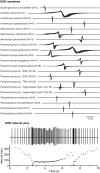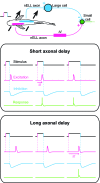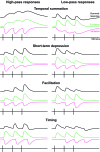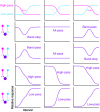Multiplexed temporal coding of electric communication signals in mormyrid fishes
- PMID: 23761462
- PMCID: PMC3680504
- DOI: 10.1242/jeb.082289
Multiplexed temporal coding of electric communication signals in mormyrid fishes
Abstract
The coding of stimulus information into patterns of spike times occurs widely in sensory systems. Determining how temporally coded information is decoded by central neurons is essential to understanding how brains process sensory stimuli. Mormyrid weakly electric fishes are experts at time coding, making them an exemplary organism for addressing this question. Mormyrids generate brief, stereotyped electric pulses. Pulse waveform carries information about sender identity, and it is encoded into submillisecond-to-millisecond differences in spike timing between receptors. Mormyrids vary the time between pulses to communicate behavioral state, and these intervals are encoded into the sequence of interspike intervals within receptors. Thus, the responses of peripheral electroreceptors establish a temporally multiplexed code for communication signals, one consisting of spike timing differences between receptors and a second consisting of interspike intervals within receptors. These signals are processed in a dedicated sensory pathway, and recent studies have shed light on the mechanisms by which central circuits can extract behaviorally relevant information from multiplexed temporal codes. Evolutionary change in the anatomy of this pathway is related to differences in electrosensory perception, which appears to have influenced the diversification of electric signals and species. However, it remains unknown how this evolutionary change relates to differences in sensory coding schemes, neuronal circuitry and central sensory processing. The mormyrid electric communication pathway is a powerful model for integrating mechanistic studies of temporal coding with evolutionary studies of correlated differences in brain and behavior to investigate neural mechanisms for processing temporal codes.
Keywords: anti-coincidence detection; coincidence detection; delay line; duration tuning; electric organ discharge; interval tuning; sub-millisecond timing differences; temporal filter; weakly electric fish.
Figures










Similar articles
-
Behavioral and Single-Neuron Sensitivity to Millisecond Variations in Temporally Patterned Communication Signals.J Neurosci. 2016 Aug 24;36(34):8985-9000. doi: 10.1523/JNEUROSCI.0648-16.2016. J Neurosci. 2016. PMID: 27559179 Free PMC article.
-
Signal Diversification Is Associated with Corollary Discharge Evolution in Weakly Electric Fish.J Neurosci. 2020 Aug 12;40(33):6345-6356. doi: 10.1523/JNEUROSCI.0875-20.2020. Epub 2020 Jul 13. J Neurosci. 2020. PMID: 32661026 Free PMC article.
-
Sensory Specializations of Mormyrid Fish Are Associated with Species Differences in Electric Signal Localization Behavior.Brain Behav Evol. 2018;92(3-4):125-141. doi: 10.1159/000496493. Epub 2019 Mar 1. Brain Behav Evol. 2018. PMID: 30820010
-
From sequence to spike to spark: evo-devo-neuroethology of electric communication in mormyrid fishes.J Neurogenet. 2013 Sep;27(3):106-29. doi: 10.3109/01677063.2013.799670. Epub 2013 Jun 26. J Neurogenet. 2013. PMID: 23802152 Review.
-
Encoding and processing biologically relevant temporal information in electrosensory systems.J Comp Physiol A Neuroethol Sens Neural Behav Physiol. 2006 Jun;192(6):625-35. doi: 10.1007/s00359-006-0102-0. Epub 2006 Feb 1. J Comp Physiol A Neuroethol Sens Neural Behav Physiol. 2006. PMID: 16450118 Review.
Cited by
-
Peripheral sensory coding through oscillatory synchrony in weakly electric fish.Elife. 2015 Aug 4;4:e08163. doi: 10.7554/eLife.08163. Elife. 2015. PMID: 26238277 Free PMC article.
-
Evidence for mutual allocation of social attention through interactive signaling in a mormyrid weakly electric fish.Proc Natl Acad Sci U S A. 2018 Jun 26;115(26):6852-6857. doi: 10.1073/pnas.1801283115. Epub 2018 Jun 11. Proc Natl Acad Sci U S A. 2018. PMID: 29891707 Free PMC article.
-
A History of Corollary Discharge: Contributions of Mormyrid Weakly Electric Fish.Front Integr Neurosci. 2020 Jul 29;14:42. doi: 10.3389/fnint.2020.00042. eCollection 2020. Front Integr Neurosci. 2020. PMID: 32848649 Free PMC article. Review.
-
Detection of submillisecond spike timing differences based on delay-line anticoincidence detection.J Neurophysiol. 2013 Nov;110(10):2295-311. doi: 10.1152/jn.00444.2013. Epub 2013 Aug 21. J Neurophysiol. 2013. PMID: 23966672 Free PMC article.
-
Genetic drift does not sufficiently explain patterns of electric signal variation among populations of the mormyrid electric fish Paramormyrops kingsleyae.Evolution. 2020 May;74(5):911-935. doi: 10.1111/evo.13953. Epub 2020 Apr 13. Evolution. 2020. PMID: 32187650 Free PMC article.
References
-
- Ainsworth M., Lee S., Cunningham M. O., Traub R. D., Kopell N. J., Whittington M. A. (2012). Rates and rhythms: a synergistic view of frequency and temporal coding in neuronal networks. Neuron 75, 572-583 - PubMed
-
- Amagai S. (1998). Time coding in the midbrain of mormyrid electric fish. II. Stimulus selectivity in the nucleus exterolateralis pars posterior. J. Comp. Physiol. A 182, 131-143 - PubMed
-
- Amagai S., Friedman M. A., Hopkins C. D. (1998). Time coding in the midbrain of mormyrid electric fish. I. Physiology and anatomy of cells in the nucleus exterolateralis pars anterior. J. Comp. Physiol. A 182, 115-130 - PubMed
-
- Arnegard M. E., Jackson B. S., Hopkins C. D. (2006). Time-domain signal divergence and discrimination without receptor modification in sympatric morphs of electric fishes. J. Exp. Biol. 209, 2182-2198 - PubMed
Publication types
MeSH terms
Grants and funding
LinkOut - more resources
Full Text Sources
Other Literature Sources

